Looking around for something new to see in your binoculars or telescope tonight? How about an object whose name literally means “new”. Japanese amateur astronomer Koichi Itagaki of Yamagata discovered an apparent nova or “new star” in the constellation Delphinus the Dolphin just today, August 14. He used a small 7-inch (.18-m) reflecting telescope and CCD camera to nab it. Let’s hope its mouthful of a temporary designation, PNVJ20233073+2046041, is soon changed to Nova Delphini 2013!

Several hours later it was confirmed as a new object shining at magnitude 6.8 just under the naked eye limit. This is bright especially considering that nothing was visible at the location down to a dim 13th magnitude only a day before discovery. How bright it will get is hard to know yet, but variable star observer Patrick Schmeer of Germany got his eyes on it this evening and estimated the new object at magnitude 6.0. That not only puts it within easy reach of all binoculars but right at the naked eye limit for observers under dark skies. Wow! Since it appears to have been discovered on day one of the outburst, my hunch is that it will brighten even further.
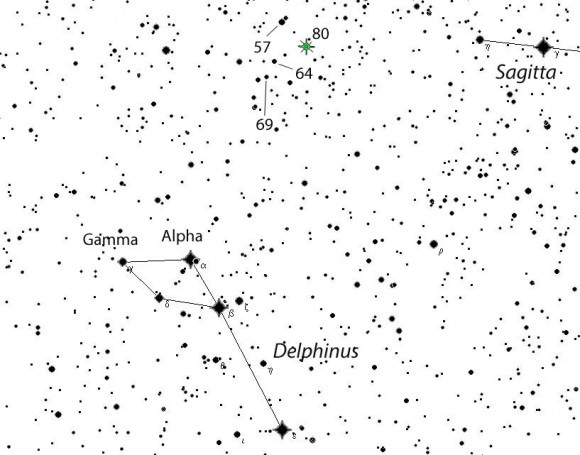
The only way to know is to go out for a look. I’ve prepared a couple charts you can use to help you find and follow our new guest. The charts show stars down to about 9th magnitude, the limit for 50mm binoculars under dark skies. The numbers on the chart are magnitudes (with decimals omitted, thus 80 = 8.0 magnitude) so you can approximate its brightness and follow the ups and downs of the star’s behavior in the coming nights.
Despite the name, a nova is not truly new but an explosion on a star otherwise too faint for anyone to have noticed. A nova occurs in a close binary star system, where a small but extremely dense and massive (for its size) white dwarf grabs hydrogen gas from its closely orbiting companion. After swirling about in a disk around the dwarf, it’s funneled down to the star’s 150,000 degree F surface where gravity compacts and heats the gas until it detonates like a bazillion thermonuclear bombs. Suddenly, a faint star that wasn’t on anyone’s radar vaults a dozen magnitudes to become a standout “new star”.
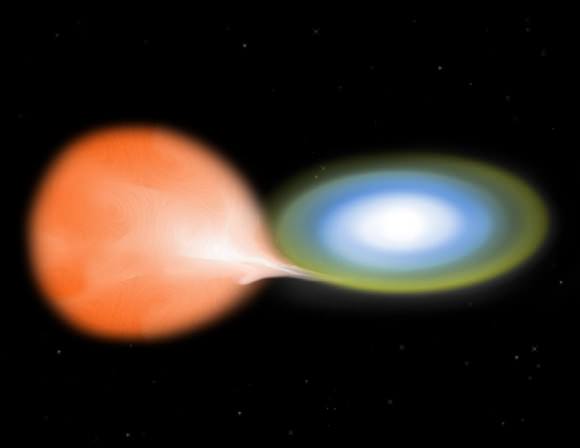
Novae can rise in brightness from 7 to 16 magnitudes, the equivalent of 50,000 to 100,000 times brighter than the sun, in just a few days. Meanwhile the gas they expel in the blast travels away from the binary at up to 2,000 miles per second. This one big boom! Unlike a supernova explosion, the star survives, perhaps to “go nova” again someday.
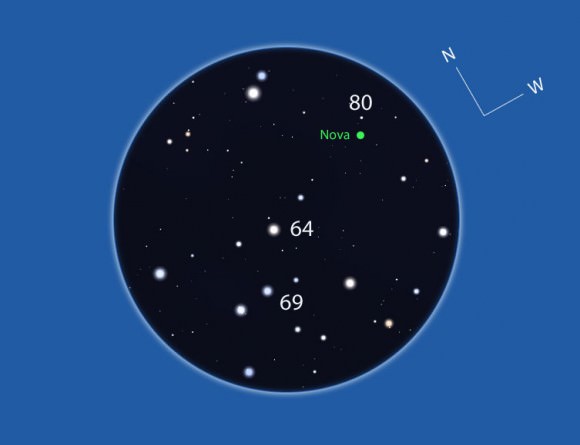
I’ll update with links to other charts in the coming day or two, so check back.
See info on the Remanzacco Observatory website about their followup images of the nova.

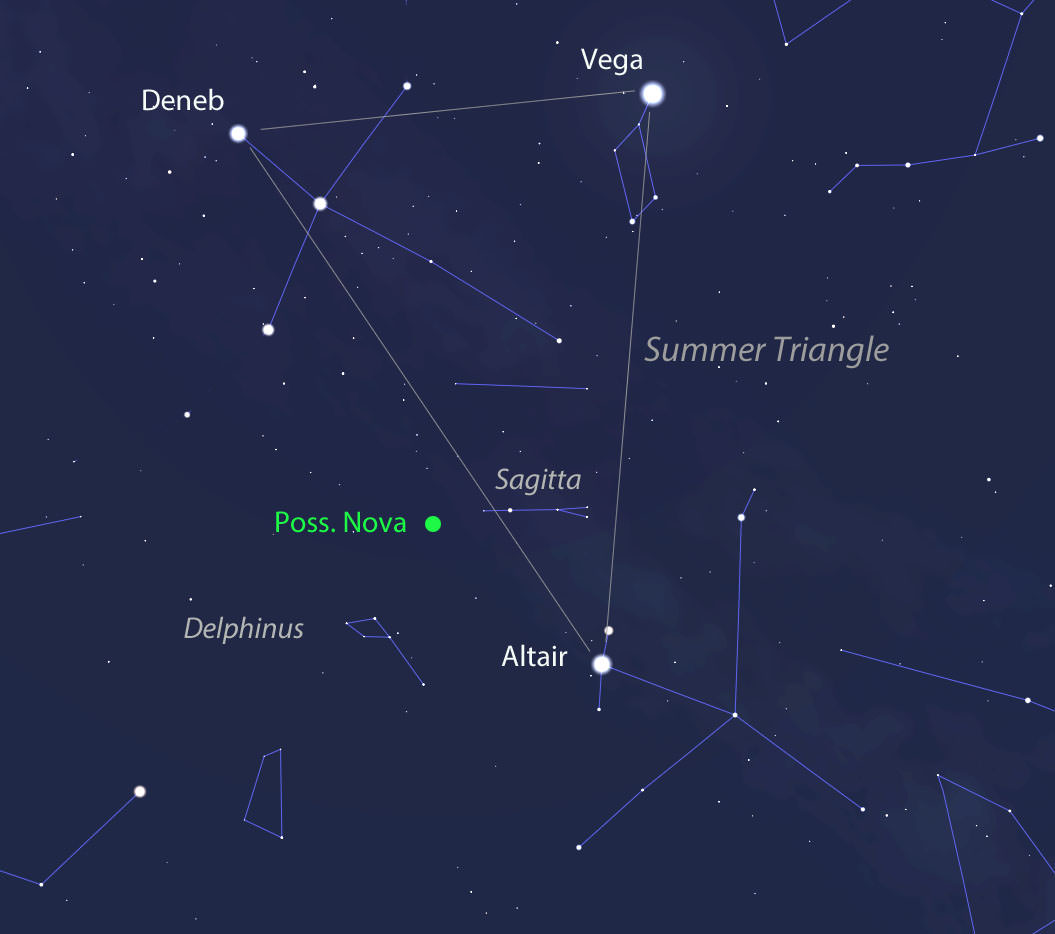
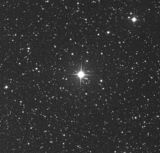
Located! Awesome!! You could have lifted the top border a bit on the maps above, to highlight the H-like structure of the group of stars just to the east (left) of the Nova. This is easy to find just going straight up from the “back” of the Dolphin. The Nova makes the right bottom star of a perfect triangel with the central star to the right of the H-structure, and an equal ca 6 Mag star north-west (over and to the right) and above the Nova. Just used a simple 10×42 binoculars on a tripod in the backyard. Thanks!
Thanks Ole. I was trying to juggle size on the Web while still relating it to Delphinus. I agree though. I plan to re-work the charts sometime later this evening.
Bright New Nova In Delphinus from !04 San Marcello
http://b09-backman.blogspot.com/2013/08/nova-nel-delfino.html
Just saw it with 10×50 binoculars. Cool! I started in delphinus from delta to alpha until I got to the “C” shaped group of stars (the “69” star forms the tip of the C). From there it’s easy to identify with the 2 degree field image above. Both it and the “57” star have dimmer stars immediately to their upper right approximately the same distance away.
Definitely brighter tonight
I looks real close to the Blue Flash Nebula (NGC6905) but every finder chart fails to show the planetary nebula …
What’s the distance of this nova?
Dang.. been a busy, busy Bee lately and haven’t been checking in! Today’s the 15th…… Hmm. Updates appreciated. DEFINITELY something worth taking the scope out to see! 5:50 pm an quite light here.. BBL
Had dinner.. it got dark… I assembled my gear and went outside… to see a thick marine layer/cloud bank. Put the equipment back. Looks clear so far tonight! Yesss!
I caught it on camera last night. It’s very nice: http://www.astro-photo.nl/deepsky/nova-delphinus-2013
Impressive.
Does this mean it’s one of the “Standard Candle” novae? That we will be able to pinpoint it’s location in three dimensions?
Seen! In Genoa (Italy), with binoculars 8*30.
Tnank you very much for the useful info anch charts!
I estimated the magnitude tonight at ~4.8. Using 10X70 binoculars. Just a little fainter than zeta delphini. And despite outer London skies and half moon, I can just see it at the limits of my naked eye visibility, knowing exactly where to look.
When did this star go nova? I had seen a object grow very bright last August or September in the area of Delphinus and then fade out but it was to long for it to be a straight on meteor.
How often does a nova this bright occur?
If you picture 69 and 64 as the top of a ram’s face triangle who only has one horn (to left on our charts–but would be right for the ram), then the nova is where the tip of the missing horn would be!
Yesterday I tried to get a photo (simply using a camera + tele), I choose three:
http://www.scuderialabellaria.it/IMG_9768.JPG
http://www.scuderialabellaria.it/IMG_9784.JPG
http://www.scuderialabellaria.it/IMG_9793.JPG
Very easy to identify it, it is really brilliant. Anyway, here is also my third photo to which I added a couple of yellow arrows pointing at it:
http://www.scuderialabellaria.it/IMG_9793_frecce.JPG
Sorry. I see that the page loads my 4 images mentioned in a previous post. I don’t know why, I just wanted to post their URLs
This could be calculated at 6500 light years
Awesome! I will find this new nova. Thanks!
It’s possible to see yet? I saw a very bright last night and I don’t remember if it’s a planet or not. Is’t possible to see the new nova with naked eyes?